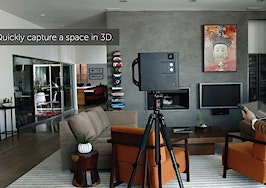Kaspar Helfrich is the chief executive officer of Archilogic.
Age: 31
Degree: Architecture, ETH
Location: Zurich, Switzerland

Kaspar Helfrich in New York City
What’s your favorite activity outside of work, and why?
I still love drawing. It was part of my education as an architect, not just a training in a skill, but a training in how to see, and how to communicate without words.
Otherwise, I also still really enjoy crafting furniture. I made a fair amount of the furniture that I still live with, and friends still ask me to make them furniture sometimes, although I often don’t have time anymore. I’m really proud that a shelf that I designed with my co-founders — Tomas Polach, Pascal Babey and Frederic Schwarz — will be mass-produced by ZeitraumMoebel.de and presented at the Salone di Mobile in Milan in April this year.
I guess both drawing and making are a kind of architect’s therapy, a way of thinking about the principles of building without buildings.
What’s your favorite classic piece of literature and why?
I have an addiction to science fiction. The classic would be Asimov’s “Foundation Trilogy.” It’s something I reread. It’s essentially projective, about the consequences, intended or not, of human actions.
William Gibson’s “Neuromancer” is a classic, written in 1984 (!) and it’s essentially about virtual reality. Most recently, I’ve really enjoyed Andy Weir’s “The Martian,” a story about an astronaut stranded on Mars forced to adapt and invent to survive. It’s kind of a hyper-contemporary “Robinson Crusoe.” Unlike a lot of science fiction, the plot line is entirely constructed from interactions with available technology. Weir initially wrote it on his blog, and it was a runaway success because of public demand, rather than marketing.
Are you the first entrepreneur in your family?
I guess not. Anyone who takes risks is an entrepreneur. My father is a writer, and artists intrinsically are entrepreneurs. …
How did you come up with the idea for Archilogic?
Archilogic has a collective identity. When Tomas, Pascal, Frederic and I were students at the ETH (the Swiss Federal Institute of Technology), we payed our way through college by producing sophisticated renders, which are useful for architects and real estate companies. But this always seemed backward to us. Why were we modeling data in 3-D and then using that to generate passive 2-D images? The data wanted to be more than an image, it wanted to be executable.
It was always obvious to us that these models would one day be 3-D. We always thought that someone should automate both the models, and their production, and as no one did, we began to do it ourselves.
We also knew that the production of images controls architecture, and so if we really wanted to change architecture, we needed to change the way architecture was represented.

The Archilogic team
Describe a time when you felt particularly insecure about the future of Archilogic. How did you bounce back?
When we began, we didn’t know who else was in the market. When I first realized the scale and financing of the competition, I was terrified. But then I realized that if there were all these companies out there, trying to achieve similar things, that was also confirmation that there was a market. The sense of being in a race confirmed our conviction that there was also a serious goal.
I still worry every time we grow. Every increase in size involves greater responsibilities and commitments.
What would you describe as your company’s biggest victory since you joined it?
When we tested our plan recognition! The first time that I saw walls automatically extrude out of a scanned floor plan, that was amazing. It turned a 2-D picture into something that was not only 3-D, but made of executable code, something that could be explored, interacted with, reconfigured. We went from a representation, a stupid image that needed a professional to interpret it, to a 3-D model that could almost be described as alive. It’s hard to describe how uncanny and exciting that was.
What’s been the biggest obstacle your business has encountered, and how have you dealt with it?
I come from an architect’s point of view, which is incredibly attached to space. We care about spatial relations. Real estate, as an industry, still often sees buildings in terms of so-and-so many thousand square feet, rather than the complexity of cubic volumes. The translation from 2-D to 3-D involves learning (and teaching others) how to deal with a whole lot of things currently treated as intangible, or too subtle to be measurable. We think that a new way of presenting space will lead to a new way of thinking about it, new metrics, new performance indicators and new methods. We’ve got to break through flatland.
What puzzles you most about the industry?
Sometimes the resistance of the industry to changes that have already happened … I’d have to go back to science fiction to explain. Asimov said, or nearly said, “Fiction is not a genre, it is a way to tell a a story.” Within science fiction there is crime, romance, all the other genres of fiction. What makes science fiction special is that it’s a new form for telling these universal types of stories.
In the same way, the Internet is not another marketplace alongside established markets; the Internet transforms the transaction of business. It’s not a competitor but an accelerator. So I’m always struck by people who see it as something to be resisted.
What is the most important lesson you’ve learned about building a business?
I guess the first rule is “ask.” From day one at Archilogic, we went out to every single potential client to ask them what they wanted. We could imagine a million things we wanted to develop, but you can only build a business on actual needs, otherwise what you have is a solution in search of a problem. Internally, as well as externally, it’s all about communication — fluid, open exchange.
What’s the most overrated real estate technology?
Static renders; they’re a misuse of the medium. While they can be manipulated to look appealing, they tend to deceive. Renders also tend to create facade-driven perception of architecture even as the actual space that we live within becomes more and more standardized and formulaic.
People mistake these images for architecture, but actually it’s interiors that determine most of our experience.
Also, they’re a waste of computing power and effort. Renders creates a static image from what should be an interactive piece of code. Why shouldn’t a picture of a building also be the plan that the client and the developer use to help design the building, or act as a live map, or be put to any number of other useful ends?
How will the role of the real estate agent change over the next five years?
That’s a really hard question, but my guess is that the profession will change like every profession under the influence of constantly expanding automation. The traditional agent might evolve into something closer to a service provider, someone who facilitates a move, welcomes you to a new place. As real estate deals become more complex, agents need to be across all the dimensions of it, and even external questions: from risk, to execution, to law. The agent won’t be solely about commission, but will need to add value to every deal that comes across their desk. It will require the flexibility and adaptability of a, well, a Robinson Crusoe or a Mark Watney.
What motivates you more: power or money?
Neither are strong motivators. Power is one side of a coin, the other side of which is responsibility. And money is only a fuel for doing things, it doesn’t help you know what to do.
What drives me is curiosity, I want to see the possibilities of the technology we are developing emerge. We know how our models help to sell individual properties, but not what happens when we connect all this new data in new ways, and I guess this goes back to the question of adding value and changing the way that real estate is measured, and architecture is understood.
What is your biggest professional fear?
Every day I go to the office and I know that on that day I will make decisions that will affect other people, and some of them will be mistakes. My constant fear is that the mistakes that I make on any given day will outweigh other decisions that I have made, in a way that will negatively influence the lives of others or the future of Archilogic.
What is your biggest personal fear?
I know it’s typically European, but I worry a lot about the environment.
Whom do you respect most in the industry?
I respect everyone with skin in the game who still manages to think past the next balance sheet. The people who see business as a creative activity, and professional relationships as also human ones.
Coming soon: Read a rundown from Archilogic staff on what it’s like to work in an environment with no single leader and a democratic strategic plan. Look for it on Inman soon.
Would you like to participate in Inman’s leader profile series? Email amber@inman.com.







